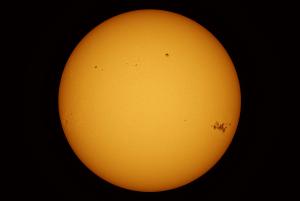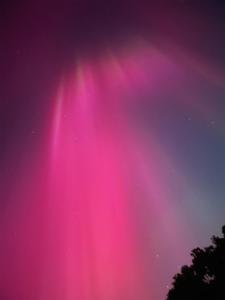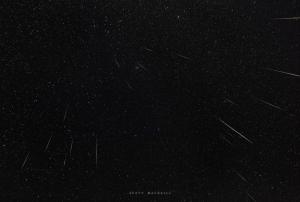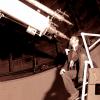Celebration of Space - October 18, 2024
_2500-Brian_Nieves_1729274865.jpg)
Comet C/2023 A3 Tsuchinshan-ATLAS over Frosty Drew Observatory. Credit: Frosty Drew Astronomy Team member, Brian Nieves, captured this image on Tuesday, October 15, 2024.
Save the Date!
Frosty Drew presents: A Night with a Comet, an event tailored to viewing Comet C/2023 A3 Tsuchinshan-ATLAS.
$5 per person over four years of age.
Starting at 6:30 pm on Saturday, October 19, 2024, we will have telescopes focused on the comet, offering views of different magnifications. We will have a telescope fitted with a camera providing live streamed views of Comet A3 on screens around the campus. Even though the bright Moon will rise during the event, the comet should still be visible to the naked eye. The event will run until 9:30 pm, which is around the time the comet will set. Stop in for a night with Comet C/2023 A3 Tsuchinshan-ATLAS and see the comet for yourself.
This past week brought Comet C/2023 A3 Tsuchinshan-ATLAS (A3) to the evening sky, and naked eye views have been spectacular. Comet A3 is the brightest comet we have had in the Northern Hemisphere since Comet C/1995 O1 Hale-Bopp in 1997. Unfortunately, the best views of the comet are being hindered by the presence of the bright Moon, but over the next several nights, the Moon will be rising later, making for better views. Even though the comet has offered fabulous views these past few nights, the comet is quickly dimming. This happens as the comet moves further from the Sun. Within the next few nights, the comet will likely dim to binocular viewing levels, but it will remain a fabulous site for the remainder of October. The Frosty Drew Astronomy Team has been out and about capturing views of the comet from different locations. On Tuesday and Wednesday nights, Frosty Drew Astronomers were at the Observatory capturing fantastic images of the comet. Over the next several nights, the comet will continue to dim, but the Moon will also be departing the evening sky. Check in regularly with our photo gallery of Comet A3 for updates over the next several nights.
This past Tuesday, October 15, 2024, NASA and NOAA released a statement marking the start of Solar Cycle 25’s solar maximum period. Solar maximum is the active side of the Sun’s eleven (11) year sunspot cycle. The cycle starts and ends with solar minimum, where there is little-to-no activity on the solar photosphere (surface of the Sun). A few years after the new solar cycle begins, sunspot activity increases very quickly towards the very active side of the cycle. As we have seen in past cycles, solar maximum comes on quickly, and slowly fades over several years into solar minimum. Over the past six months we have seen some exceptionally fantastic displays of the Aurora Borealis, some of which have been visible as far south as Mexico. These types of geomagnetic activity are not common occurrences, and are indicators that the current solar cycle (Cycle 25) is much more active than predictions had noted. So what is a sunspot, you may ask?
Sunspots form on the atmosphere of the Sun that we generally consider the Sun’s surface – the photosphere. They are a product of convection and plasma. Over thousands of years, energy released from hydrogen fusion in the core of the Sun will travel to the photosphere. This energy will travel along little pieces of solar material called granules, which rise to the photosphere, release the energy into the solar chromosphere, flip over, and sink back into the Sun. The material that is rising is a plasma, so it has dipolar magnetism (N and S poles). As granules reach the photosphere, they may connect with other granules rising nearby and remain on the photosphere. A magnetic field will form over this grouping of granules, which shields them from surrounding radiation on the photosphere. The result is that these regions will cool about 4,000º, which makes them appear dark. This is a sunspot.
Over the next few years, sunspot activity will continue at the rates we are seeing today. This will result in the potential for additional Aurora sightings like we have had in May and October. So keep your eyes on the sky, you never know when you may see something spectacular.
On Sunday-Monday, October 20-21, 2024, the annual Orionid Meteor Shower peak will occur. Bringing with it an increase in regular meteor activity by about 20 meteors per hour, the Orionid peak is a moderate display of meteor activity. Particles that make up the Orionid shower are remnants of the famous Halley’s Comet (1P/Halley). As Halley’s Comet completes its 74 year orbital period, it leaves small dust-rice sized pieces of debris along its orbit. Every October, Earth orbits into this debris field, and particles of Halley’s Comet enter Earth’s atmosphere at 41 miles per second, and burn up. We see this as a fast streak of light across the sky, like a shooting star.
In 2024, the 86% waning gibbous Moon will outshine all but the brightest meteors of the Orionid Meteor Shower peak. Being that this shower is rather moderate to start, the Moon will make it difficult to spot the increase in meteor activity. Fret not, in early November the annual Taurid meteor showers will begin, and the Taurids are known to bring a significant increase in fireball meteor activity. Fireball meteors are brighter than average, often light up the landscape, and can streak across the entire sky. So save your meteor viewing enthusiasm for November, and sit out the Moon laden 2024 Orionid peak.
- Author:
- Scott MacNeill
- Entry Date:
- Oct 18, 2024
- Published Under:
- Scott MacNeill's Columns




